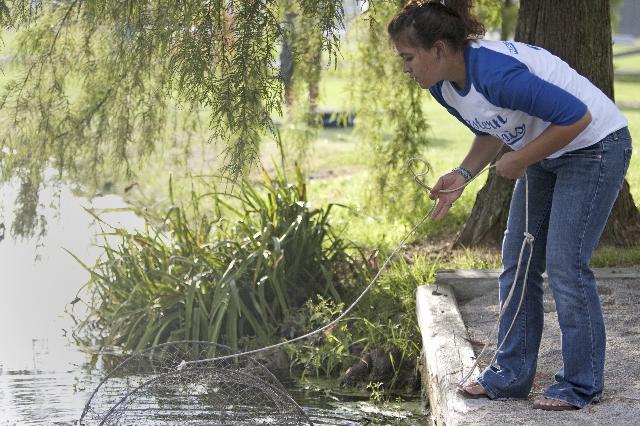Feature Photo: Slow and steady wins the turtle
Kevin Rutter, 2010 Teacher of the Year, gave his advice to future teachers in the Buzzard Auditorium 7 p.m. Tuesday.
“You might notice the strange things out of my mouth,” Rutter said. “That’s just my Chicago accent.”
In order to be chosen as teacher of the year, Rutter had to be nominated by someone in his district and then come up with around 10 recommendation letters from everyone from his administration to parents, students and community members.
Rutter was then selected as a top 10 candidate out of every school district in the state.
The final 10 participated in taped interviews. The tapes were then given to the previous teachers of the year who narrowed the choices down to three.
Out of the top three, the teacher of the year is chosen.
“For some reason, they chose me,” he said.
One of the perks of being teacher of the year is that Rutter got to meet President Barack Obama in Washington, D.C.
At a black tie event before he was able to meet the president Rutter said he proposed to his then girlfriend, which led to an eruption of awes from the crowd.
“I just thought it was the right time,” he said.
Rutter is an Eastern graduate from the class of 1997.
He is a social sciences teacher at Carl Shurz High School, located four miles west of Wrigley Field in Chicago.
Carl Shurz is a public school which means students do not have to test in to go to the school.
Carl Shurz was not Rutter’s first school.
“(At Eastern) I thought I had it made,” he said. “I was wrong in thinking that was the case.”
Rutter substituted after graduation and was an aid before he received his own classroom and students.
He has been teaching at Carl Shurz for nine years, starting today.
During his presentation, Rutter gave advice to future teachers.
1. Prepare yourself to be challenged
Rutter talked about how challenging teaching can be.
“Not only do challenges come for breakfast, they come for lunch in a brown paper bag and for dinner,” Rutter said.
Rutter said that teachers must accept and be able to deal with challenges.
2. Persevere
Rutter said a teacher must learn how to persevere in order to keep up with the job.
“Don’t take on the challenges by yourself,” he said. “Find someone you trust.”
3. Tap into technology tools
Rutter told the story of how his niece took his laptop from his hand because he was typing “too slow.”
“Reminds me of that everyday,” he said.
Rutter said with technology changing so fast, teachers must try to keep up.
With his award, Rutter received a package of technology for his classroom along with training to learn how to use it.
“If I want them to learn, I have to add that in what I do,” he said.
4. Make it relevant
“You have to be the one to make the sell,” Rutter said.
He talked about how teachers always have to “sell” their content to their students because students do not always care.
5. Try to make things simple
Rutter said it is better to make things as simple as possible for students.
He said the education system is so complex, it takes at least five years of teaching to understand.
“The goal your first year should be just to keep your head above the water,” Rutter said.
6. The “three pancake rule”
The “three pancake rule” means it may take more than one try to get something right.
“Always follow the ‘pancake rule,'” Rutter said.
Rutter said teachers should try new things and “not be too hard on themselves.
Justin Tomaska, a senior kinesiology and sports studies major, said he learned a lot from the presentation.
“Everything he presented was great ideas for teachers,” Tomaska said.
Ashley Mayor, a senior music education major, agreed with Tomaska.
“I liked how he keeps it simple with his students,” she said. “I liked how he said just be yourself when you teach.”
Approximately 200 people attended the event, Rutter said.
Courtney Bruner can be reached at 581-7942 or dennewsdesk@eiu.edu.
Feature Photo: Slow and steady wins the turtle
Sophomore biology major Angie Bradley sets turtle traps in the Campus Pond Thursday. Bradley will then study the turtles to see what changes occur in the population as the temperature gets colder. (Danny Damiani






































































